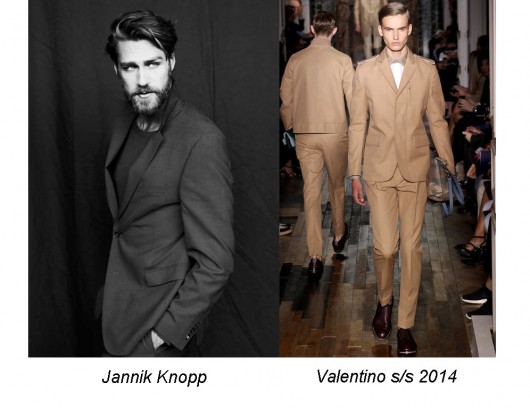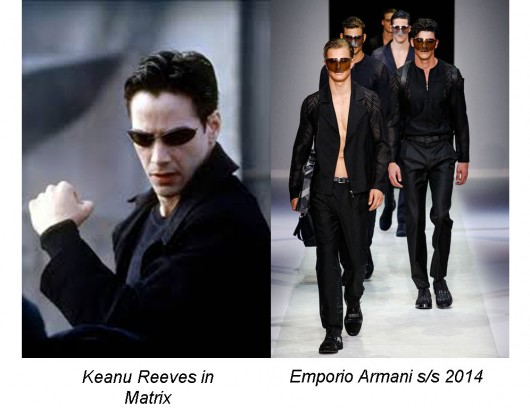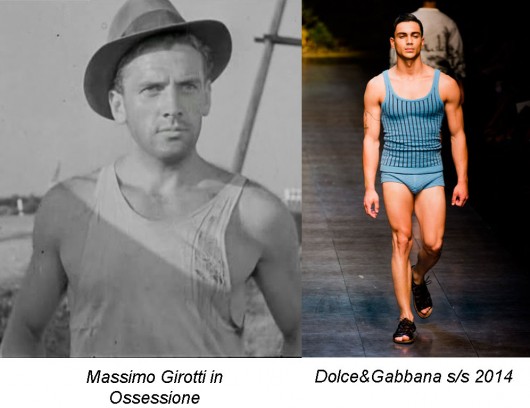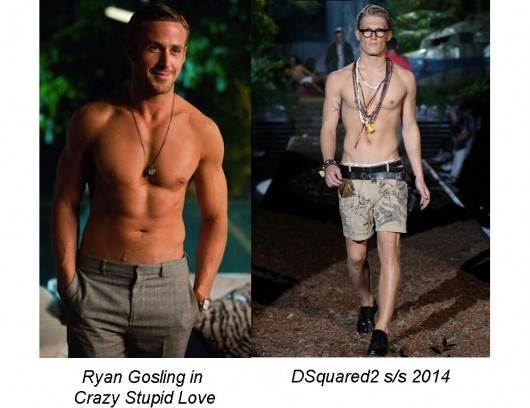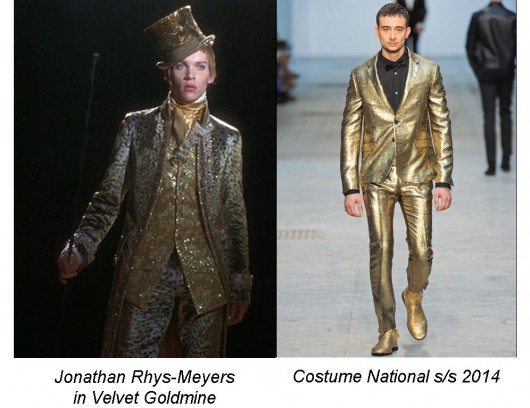BAD, BAD BOYS
Harrison Ford, il buono di “Blade Runner”, deve vestirsi come i cattivi per avere la meglio; idem come sopra per Tom Cruise nella saga di “Mission Impossible”. L’eccezione che, come sappiamo, “conferma la regola” è Mads Mikkelsen/Le Chiffre in “Casino Royale”. E’ impeccabile e sofisticato nello stile tanto quanto Daniel Craig, ma Le Chiffre cattivo è e cattivo resta. E’ innegabile che il fascino – un po’ stereotipato ma sempre in auge – del pensiero “gli uomini che mascalzoni” susciti più di un palpito nei cuori femminili e maschili (di quei maschi a cui piacciono i maschi, s’intende): da sempre e ovunque, la canaglia piace.
La musica popolare spagnola, per esempio, rigurgita di “coplas” dedicate a fascinosi banditi che hanno i loro covi nelle Sierras – disseminandole di amanti e aspiranti tali – ed è pressoché scontato che i bandoleros a un certo punto vengano acciuffati e sbrigativamente spediti alla garrota, lasciando in lacrime torme di fanciulle. In sintesi: l’immaginario collettivo pullula di figure di riferimento “in negativo” con un loro appeal irresistibile benché fuorilegge. Lo stesso discorso vale per la moda Uomo dei nostri giorni, secondo variazioni sul tema ampiamente articolate nel segno della fluidità che permea oggi sia lo stile che l’approccio al vestire.
Nella costellazione “bad glam” riveste un ruolo primario l’eroe alla Matrix, techno-vestito, ovviamente in nero totale. I suoi look anticipano un futuro prossimo venturo delineato con abbondanti dosaggi di fantasia. Textures e conformazioni rendono possibile ogni performance: si possono affrontare ghiacci eterni, temperature degne dell’inferno di Dante, laser perforanti. Vengono sfidate persino la legge di gravità: Mission Impossible, appunto. Lontano mille miglia dal prototipo Matrix è il cattivo divenuto tale per malasorte più che per malvagità d’animo. Ha la giustizia contro, ma conosce il significato della parola sentimento e sa amare. E’ una figura in equilibrio tra il delinquente e il perseguitato. Anche per questo piace. E non si può non perdonare.
Nelle nostre contrade una volta si chiamava guappo o picciotto, ma in verità è una figura universale. Può venire dal Bronx, dal Mid West impoverito dalla Grande Depressione, dalla Parigi impietosa alla Jean Gabin, come dai bassifondi di Buenos Aires. A dire il vero il suo guardaroba è un po’ male in arnese, ossia si articola intorno al must della canotta che mette ben in evidenza muscoli imprescindibili ed eventuali tatuaggi. O meglio, spesso c’è solo la canotta che in genere è anche un po’ sdrucita. Ma tant’è: lui è comunque un’icona. Negli orizzonti nostrani il capostipite di questo cattivo dal cuore d’oro e dai tanti scrupoli è il bellissimo, tormentato Massimo Girotti di “Ossessione”, primo eroe neorealista, che finisce sulla cattiva strada per la perfidia della donna amata.
La galassia dei malvagi prevede anche i trasgressori, quelli che giocano volutamente con l’ambiguità, o quelli per cui il fisico prestante è oggetto da esibire. Dunque toraci nudi in abbondanza con immancabili collane, collanine e bracciali a corredo che danno vita ad una “fiera delle vanità” del Terzo Millennio, agli antipodi rispetto al romanzo di Thackeray dal titolo omonimo, richiamando, seppur con un ampio grado di disinvoltura, l’epopea degli hippy che andavano in India, in Nepal, in Afghanistan a ritrovare se stessi.
Se invece il cattivo è ambiguo non può non guardare al mondo del rock, a Ziggy Stardust in primo luogo, e non può non luccicare di bagliori dorati o argentati. C’è anche il cattivo che sembra perbene? Domanda difficilissima, quasi senza risposta. C’è forse il “non proprio cattivo” incredibilmente smaliziato che ostenta nonchalance e pare non curarsi delle mode, ma che, se ben osservato, rivela l’ossessione per il particolare che rende il capo tutt’altro che scontato. Ed insieme al capo chi lo indossa. Altra versione de “La fiera delle vanità” edizione 2014. Giorgio Re
Harrison Ford, the hero in “Blade Runner”, must be dressed as the villains to overcome; the same thing for Tom Cruise in “Mission Impossible”. The exception that, as we know, proves the rule, is Mads Mikkelsen/Le Chiffre in “Casino Royale”. He’s as flawless and refined as Daniel Craig, but Le Chiffre is and remains mean. The appeal – a little conventional but always in favour – of the bad boys surely makes the hearts, both ladies’ and men’s (we’re talking about men who like other men, obviously), beat: from time immemorial, and everywhere, the rogue is liked. Spanish folk music, for example, is full of “coplas” dedicated to charming bandits that have their hideouts in the Sierras – scattered with lovers – and it’s almost expected that the bandoleros at a certain point will be caught and offhandedly sent to the garrota, leaving crowds of girls in tears. To sum up: the collective unconscious is full of “negative” reference figures, with an irrestistible but outlawed appeal. The same goes for today menswear, along variations on the theme. In the “bad glam” constellation has a main role the “Matrix” hero, techno-dressed, in total black. His outfits anticipate a near future outlined with high doses of fantasy. Textures and shapes make every performance possible: from facing the ice-cold, the infernal temperatures or lasers, to defy the gravity law. Mission Impossible, exactly. So far from the Matrix prototype is the character become mean due to bad luck. He has the justice against, but he knows the meaning of the word love. He’s both criminal and persecuted. He’s appreciated also for this reason. And he must be forgiven. In italian districts he was called guappo or picciotto, but he’s indeed a universal figure. He can come from the Bronx, from the Midwest of the Great Depression, from the unmerciful Paris or the shallows of Buenos Aires. To tell the truth his clothes are a little down at heel: the must is a torn tank top that shows unavoidable muscles and potential tattoos. But he’s an icon in any case. The forefather of this golden heart villain is the gorgeous and tormented Massimo Girotti in “Ossessione” (Obsession), first neorealist hero, that ends up on the bad side due to his beloved’s wickedness. The galaxy of villains includes also the transgressors, that intentionally play with ambiguity, or constantly show their fine body. Such an abundance of naked chests with inevitable necklaces and bracelets gives birth to a “Vanity Fair” of the Third Millennium, poles apart from the namesake novel by Thackeray, recalling, even if with a high amount of confidence, the hippies’ epic through India, Nepal, Afghanistan. But if the villain is ambiguous he belongs to the rock world, and he likes golden or silver glares, just like Ziggy Stardust. Is there the bad boy who looks like a good one? Difficult question, hardly with answer. Maybe there’s the “not so mean” incredibly shrewd that flaunts nonchalance and seems not to care about trends, but, if carefully observed, reveals the obsession for the detail that makes the clothes anything but ordinary. And, with the clothes, who wears them. Another version of the 2014 “Vanity Fair”. Giorgio Re





